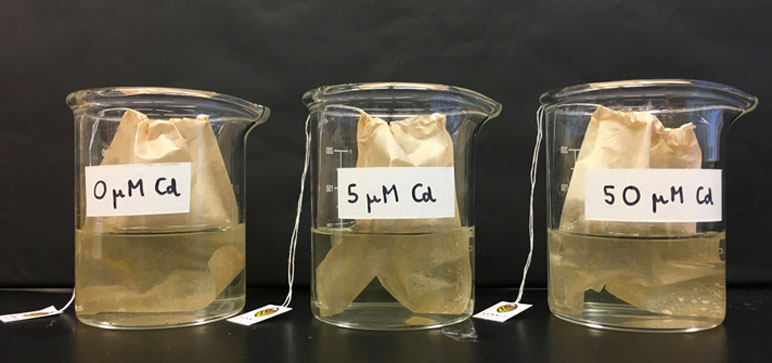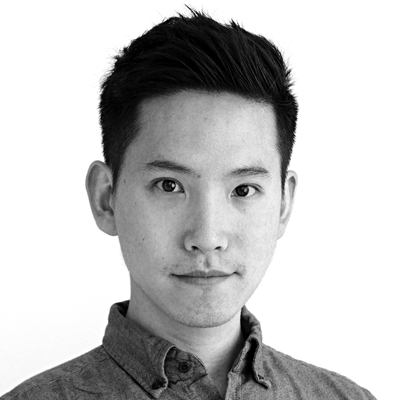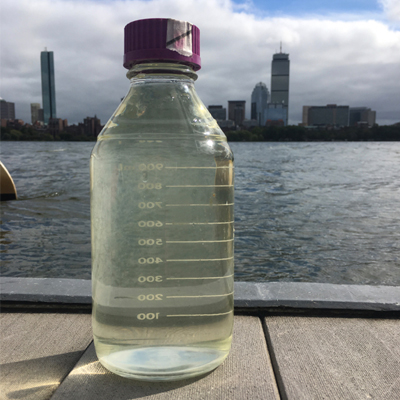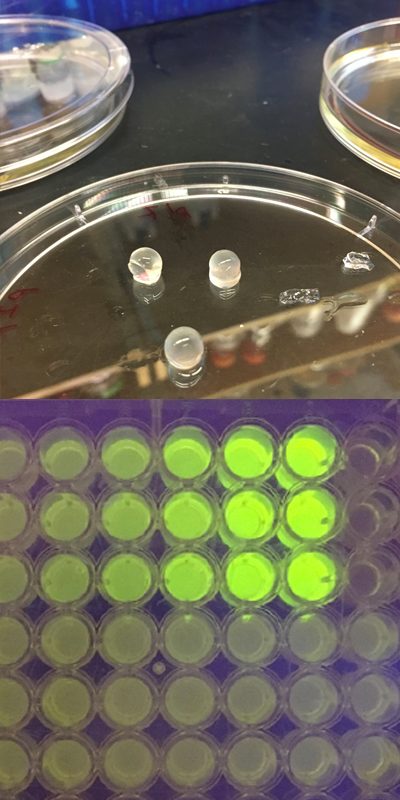News J-WAFS Student Spotlight: MIT PhD student grows a living water sensor
April 27, 2018

Photo credit: Zijay Tang
Just one year ago, J-WAFS launched our inaugural graduate student fellowship program. Nominated last spring by Prof. Tim Lu in the Department of Biological Engineering, PhD student Tzu-Chieh Tang (Zijay) was selected for the first J-WAFS Fellowship in Water Solutions. In this interview, Zijay shares details about his background and the unique water sensor he is developing that takes its inspiration from living systems found in nature.
Zijay, originally from Taiwan, came to MIT after completing a masters at the Masdar Institute in the United Arab Emirates. He is now a PhD candidate in biological engineering, where he works across disciplines to develop engineered living materials that can sense and respond to environmental stimuli—contaminants in particular—to become living sensors that can both record contaminant levels in water supplies and serve as bioremediation tools.
J-WAFS communications and program manager Andi Sutton interviewed Zijay about his fascinating research area and the path that led him to it.

Photo credit: Zijay Tang
What brought you to study at MIT?
When I was an undergrad, I was focused on pure biology: life sciences, the taxonomy of animals and plants, those kinds of things. Back then, synthetic biology was a new field. I came across a paper in those early years that talked about how you could apply the principles of computer science and electrical engineering to do circuit design in living cells, and I thought, “This is really cool!”
I’ve always looked to nature for inspiration. Many living things have self-cleaning and self-healing surfaces. They’re all out there in nature! Since it’s very difficult to replicate these processes using artificial approaches, I wanted to know how I could use a living part of nature to recreate these systems. So of course I looked to MIT, which is one of the strongest places to do research in synthetic biology. Since we also have a strong materials science community, which spoke to my interest in materials and surfaces, it was a good combination for me.
Your work spans many disciplines and departments. Can you tell us a little bit about your affiliations with each department, and what you bring to these programs?
While most of my work is in Prof. Lu’s Synthetic Biology Group, I first started to think about MIT because I wanted to work with Prof. Neri Oxman, who directs the Mediated Matter research group at the MIT Media Lab. The focus of her group is to design materials inspired by nature and designed by nature. I was really fascinated by that idea. So when I arrived I proposed to combine her expertise and Professor Lu’s, and have them both as co-advisors.

Photo credit: Zijay Tang
The culture of the departments is different, though, as is the approach to research. At the Media Lab, labs there often build on discoveries in science that have already been developed and characterized in detail by others in and outside of MIT. This allows them to combine ideas in creative ways and do relatively rapid prototyping that can be quickly applicable to product development. In the case of Prof. Oxman’s group, for example, people are focusing on design projects that build on a foundation of research in biology. When it comes to building the new biological systems that I am working on, each project might take years to complete. Therefore, it can be difficult to synchronize between the two approaches. Right now I want to focus on building a foundation for how to build functional biological systems, so my focus is primarily in biological engineering, but I still find ways to collaborate with the Media Lab group. Only at MIT can you find this cool environment where you can work with two people doing very different things in such close proximity.
Let’s get into your water sensing work. What problem are you trying to solve with the biological systems you are developing?
Currently, all water sensing can be done with electronics or mass spectrometer, which have better results than our biological sensors can provide. Then, even though bio-sensing has been out there for awhile, people haven’t yet found a way to deploy the sensors safely and cheaply. Our lab is trying to solve this problem. We want to prove how biosensors can have advantages over electronics, such as functioning without a power supply so that they can be used in remote areas without good infrastructure.

Photo credit: Zijay Tang
So, how do they work?
What our lab is doing is engineering living materials that can sense and respond to environmental stimuli. We are using synthetic biology to engineer microbes such as E. coli and budding yeast to sense and record specific contaminants (heavy metals and other chemicals) by lighting up when they come in contact with them.
The major challenge of making a device out of living materials is that there is no actual structure to contain the cells. The E.coli that we use are free-floating; they don’t form a bulk material. So, we worked with Professor Xuanhe Zhao’s group in Mechanical Engineering to use a tough hydrogel they developed to contain them. This serves as a division of labor: the hydrogel provides the structural integrity, and the engineered bacteria do the sensing.
Does this pairing result in the self-generating living system that you were originally inspired to make?
Actually, no. What we’d really like to do is see if we can make the microbes, or other living organisms, produce their own container as well as do the water sensing. This is what I’m working on now. I’m collaborating with someone in the Department of Bioengineering at Imperial College London, as well as another lab in MIT’s Department of Materials Science and Engineering, that uses yeasts to do bioremediation, to create a kombucha-inspired living filter that can sense and remove chemical and biological contaminants. The work is still in its early stages, but the results are promising.
Synthetic biology often has such a long time horizon, as you’ve said. How do you define completion when it comes to this project?
For me and for some other people in my lab, completion will mean that we can beat the results of the electronic water sensor counterparts in terms of specificity and sensitivity. But we are not there yet. I believe that if we can show the potential of our bio-sensors to be viable water sensing products for industry, we might get more support.
What would be needed is research into optimizing the sensors to see the true extent of their potential. This is another way that J-WAFS has been really helpful. Through J-WAFS, I was introduced to people at Xylem, Inc., your Research Affiliate, about their interest in this work and possible future support. This would never have happened if I had not had this J-WAFS’ affiliation!
Outside of your current work, what research directions in water sector do you think are really exciting?
Based on my experience and discussions with others in my field, it’s clear that there is already a lot of work being done in sensing and removing different contaminants like heavy metal ions and chemicals. Right now, though, we don’t have very good sensors for pathogens like microbes. I think it would be really nice if we could actually use the fact that some microbes can detect others to build bio-sensors to detect pathogens in food and water. That is where we could actually beat electronic sensors in terms of sensitivity. The issue of biological contaminants is, to me, is equally if not more important than chemical ones.
What are your next steps after MIT?
I’m really excited about the research I’ve been doing, but last year I was involved in a startup competition. So, I could see developing research for commercialization as a possible career path. But, there are so many things I still want to do, so I’m still exploring my options!